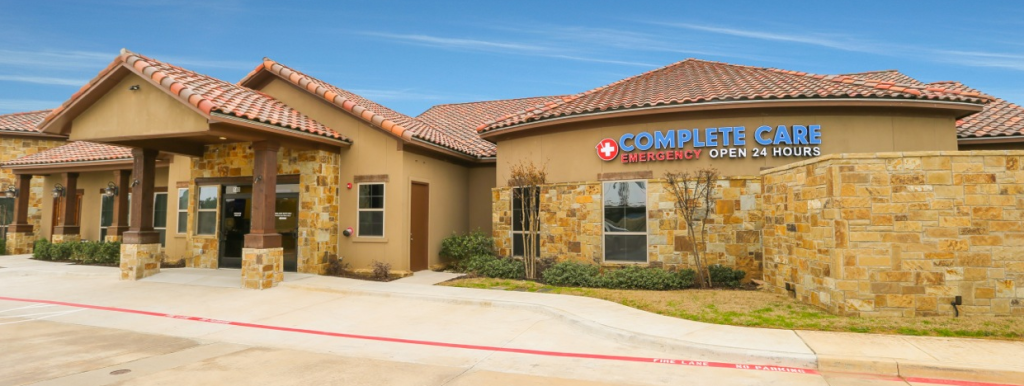When faced with a sudden illness or injury, deciding where to seek care from an urgent care vs emergency room can feel overwhelming. While both facilities provide valuable medical care, understanding which one best suits your situation can help you save valuable time to find the treatment you need.
KEY TAKEAWAYS:
- Urgent care facilities provide medical treatment for minor ailments, injuries, and illnesses. These centers are usually open for limited hours and are not typically equipped to handle medical emergency conditions.
- Emergency rooms are open 24 hours a day, 7 days a week, and are equipped to handle a wide variety of medical conditions, from illnesses and injuries to life-threatening emergencies.
- An emergency clinic will have lower wait times, full access to digital imaging and lab testing, and can treat a wider range of symptoms.
- Complete Care has two urgent care facilities: one in Austin (Lakeway Urgent Care) and one in Colorado Springs (Colorado Springs Urgent Care).
- All of Complete Care’s facilities are fully functioning, freestanding emergency rooms that can handle any type of medical condition or problem.
For those seeking high-quality emergency care without the typical hospital wait times, Complete Care’s freestanding ER locations provide an excellent alternative. Our state-of-the-art facilities offer the same level of emergency care you’d expect from a hospital-based ER, but often with shorter wait times and a more personalized experience. When every minute counts, visit your nearest Complete Care location!
For life-threatening situations, please call 911.
What is the difference between an emergency room and urgent care?
Understanding the difference between urgent care and ER services can help you make informed decisions about your healthcare needs. The main differences between an urgent care vs emergency room lie in what type of conditions they can treat and what equipment they have access to for diagnostics and testing.
Let’s explore the main characteristics of each facility type:
| Freestanding Emergency Room | Urgent Care | |
| When to Visit | Both life-threatening emergencies and non-life-threatening conditions | Non-life-threatening conditions requiring prompt attention |
| Wait Times | Shorter, lower wait times than hospital ERs due to streamlined operations | First-come, first-served; most patients seen within 15–45 minutes |
| Urgent Care vs Emergency Room Cost | Generally lower than hospital ERs while providing the same level of emergency care | Costs similar to a specialist visit copay |
| Hours of Operation | Open 24/7/365 | Set operating hours (can vary per location) |
| Staff Expertise | Same emergency-trained physicians and nurses as hospital ERs, but independent of a hospital system | Physicians and nurse practitioners trained in family medicine and urgent care; may not have specialized emergency medicine training |
| Equipment & Resources | Fully equipped with hospital-grade diagnostic and treatment technology; can observe and treat patients for up to 24 hours | Basic diagnostic testing available; equipped to handle a range of non-emergency conditions but lacks advanced emergency equipment |
In summary, an emergency room is equipped to handle a wider variety of injuries, illnesses, and conditions and has access to hospital-grade equipment so you can get results faster. An urgent care, while still a great option for seeking care, is more beneficial for minor injuries and ailments.
Urgent care vs emergency room — FAQs
Should I go to the ER or wait for urgent care?
Deciding between emergency room care and urgent care depends on the severity of your condition and the level of treatment needed. While urgent care centers handle non-life-threatening issues during limited hours, emergency rooms provide comprehensive care for all medical conditions 24/7. When in doubt, if you’re not sure how serious the condition is, heading to your nearest emergency room location will always be the safest option — especially if your local urgent cares are closed for the night and you need help.
Complete Care’s freestanding emergency rooms can treat every injury, ailment, and illness that urgent care facilities handle, plus we offer advanced diagnostic capabilities, including digital imaging, comprehensive lab testing, and specialized equipment that urgent care centers typically don’t have. This means you get faster, more thorough care without needing to transfer to another facility for additional testing or treatment.
Instead of wasting time searching for the “closest ER to me,” save your nearest Complete Care facility to your phone’s map apps so you will be ready for any emergency and know that quality care awaits.
When should I go to the ER?
Here are some examples of when an ER visit is necessary for life-threatening or serious emergencies:
- Chest pain
- Heart attack symptoms
- Abdominal pain location symptoms
- Stroke symptoms
- Severe burns
- Head injuries
- Severe breathing difficulties (shortness of breath)
- Major trauma or accidents
- Sudden nausea and vomiting
- Poisoning
- Alcohol poisoning or food poisoning
- Severe allergic reactions
- Loss of consciousness
- Uncontrolled bleeding
- Dangerously high blood pressure
- High fever
- Severe dehydration
- And more
Emergency rooms are equipped to handle critical medical situations that require immediate intervention and advanced medical technology. Even if your condition or injury doesn’t seem serious, the physicians at freestanding emergency rooms are trained and ready to treat anything that comes their way.
Here is what to expect at a freestanding ER visit
When should I go to urgent care?
If your condition is not life-threatening or doesn’t feel like a medical emergency, you can stop by an urgent care facility to be examined by a physician. These facilities bridge the gap between your primary care physician and emergency room services. So, what can urgent care treat?
- Cold and flu symptoms
- Minor cuts requiring stitches
- Sprains and minor fractures
- Ear infections
- Sore throat and strep throat
- Upper respiratory infections
- Minor burns and blisters
- Urinary tract infections (UTI)
- Rashes
- Minor asthma
- Mild dehydration
- Bug bites
- RSV
Because urgent cares operate on a first-come, first-served basis, wait times may not be as short as a freestanding ER facility, but they will be much shorter than a hospital. At Complete Care, most patients are seen within 15–45 minutes or quicker.
We want to reiterate that our emergency room facilities can treat any of the conditions listed above as well. Offering urgent care services allows our physicians and nurses to treat these common ailments quickly, while our emergency department handles more serious conditions.
What are the limitations of urgent care?
Here are some of the limitations that typical urgent care facilities have:
- Limited hours: Most urgent care centers operate during extended business hours but aren’t available 24/7, leaving gaps in coverage during nights, weekends, and holidays.
- No advanced diagnostic equipment: Urgent care facilities typically lack comprehensive diagnostic tools like CT scans, MRIs, ultrasounds, or full laboratory services, requiring patients to go elsewhere for complex testing.
- Cannot handle serious emergencies: Staff aren’t equipped to treat life-threatening conditions, severe trauma, heart attacks, strokes, or other critical medical situations that require immediate emergency intervention.
The Complete Care difference
Because our two urgent care facilities are attached to their location’s emergency room, if your condition requires more intensive care or diagnostic testing, you won’t have to be transferred to another facility. You can stay right where you are and get the quality care you deserve in a timely manner.
What is a freestanding emergency room?
A freestanding ER is a medical facility that provides immediate care for emergency medical conditions but is not physically connected to a hospital. Freestanding emergency rooms offer the same advanced medical equipment and diagnostic technology as hospital-based ERs, but with a few added benefits:
- Lower wait times
- Enhanced accessibility
- High-quality care
- State-of-the-art facilities
- Cost efficiency
Most freestanding ERs, including all Complete Care locations, provide 24/7 emergency services, giving patients immediate access to critical care whenever they need it. Our facilities are staffed by board-certified emergency physicians and trained medical professionals who can treat serious medical emergencies around the clock.
If you or a loved one is in need of emergency care, don’t spend your precious time waiting in a crowded hospital waiting room. Head to your nearest Complete Care ER for prompt, expert care without the wait.
How do I know if my condition is truly an emergency?
If you experience chest pain, difficulty breathing, severe bleeding, head trauma, or any condition you believe could be life-threatening, it’s an emergency. When in doubt, it’s better to err on the side of caution and seek emergency care.
Can a freestanding ER handle the same emergencies as a hospital ER?
Yes, freestanding ERs are equipped with the same advanced diagnostic equipment and staffed by board-certified emergency physicians capable of handling the same emergencies as hospital-based ERs. With a freestanding ER visit, you won’t have to wait as long to be seen and treated.
Are free-standing emergency rooms more expensive?
The urgent care vs emergency room cost debate is one we are familiar with, the myth being that freestanding ERs are more expensive than both urgent care and hospital ERs. While urgent care centers typically have lower upfront costs for minor conditions, freestanding emergency rooms often provide better value than traditional hospital ERs when emergency care is truly needed. The cost difference isn’t always as significant as many assume, especially when considering several key factors.
Why freestanding ERs can be cost-effective:
- Lower overhead costs than hospital-based emergency rooms translate to reduced patient bills
- Transparent, flexible billing with upfront cost discussions
- In-network partnerships with major insurance providers ensure maximum coverage
- No surprise hospital facility fees that can add thousands to hospital ER visits
- Faster treatment times mean fewer billable hours and reduced overall costs
Insurance coverage considerations
Most freestanding emergency rooms work extensively with insurance networks to minimize patient costs. Even when out-of-network, state and federal regulations often ensure visits are processed at in-network benefit levels, protecting patients from excessive charges.
Here at Complete Care, we never want billing to stand between you and the care you need. Read more about our insurance information.
For true emergencies requiring immediate medical attention, freestanding emergency rooms frequently offer comparable or lower costs than hospital ERs, with the added benefits of shorter wait times and personalized billing arrangements. The key is choosing the right level of care for your specific medical need.
Experience emergency care without the wait at a Complete Care freestanding ER
Understanding the differences between urgent care vs emergency room services can make all the difference in a medical situation. When minutes matter, knowing the closest emergency room to you can help provide you with peace of mind.
Complete Care’s freestanding emergency rooms bring advanced emergency medical care closer to home, with locations serving Austin, Corpus Christi, Dallas/Fort Worth, East Texas, Lubbock, San Antonio, and Colorado Springs. Our facilities combine the comprehensive care of a hospital emergency room with the convenience and personalized attention you deserve.
We also offer two state-of-the-art urgent care facilities in Austin (Lakeway) and Colorado Springs. Don’t wait until an emergency happens — save your nearest Complete Care location in your phone today, and rest assured knowing expert emergency care is always just minutes away.

